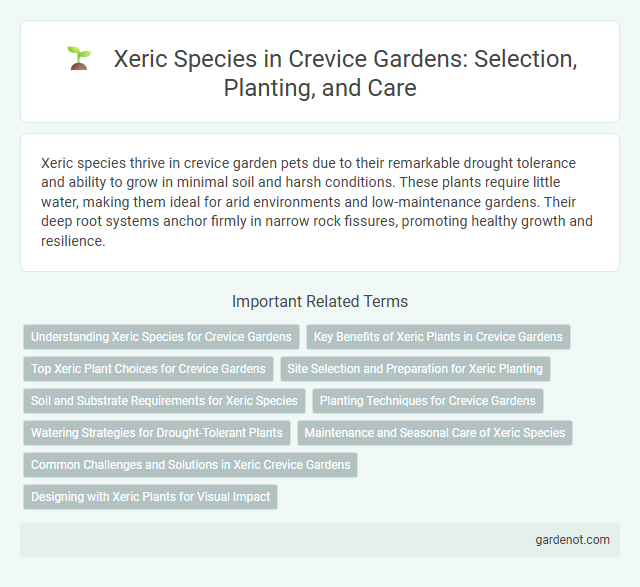Xeric species thrive in crevice garden pets due to their remarkable drought tolerance and ability to grow in minimal soil and harsh conditions. These plants require little water, making them ideal for arid environments and low-maintenance gardens. Their deep root systems anchor firmly in narrow rock fissures, promoting healthy growth and resilience.
Understanding Xeric Species for Crevice Gardens
Xeric species, adapted to thrive in environments with minimal water, are ideal for crevice gardens due to their drought tolerance and deep root systems that exploit narrow rock fissures for moisture and nutrients. These plants, including succulents, drought-resistant grasses, and alpine species, require well-draining substrates and ample sunlight to mimic their native arid habitats. Understanding the specific water needs, growth habits, and soil preferences of xeric species ensures successful cultivation and sustainability in crevice garden designs.
Key Benefits of Xeric Plants in Crevice Gardens
Xeric plants in crevice gardens maximize water efficiency through deep root systems that access moisture from narrow soil pockets, reducing irrigation needs. Their drought tolerance and adaptability promote sustainable gardening in harsh environments while minimizing maintenance demands. These species enhance biodiversity by providing habitats for specialized pollinators and contribute to erosion control within the crevice structure.
Top Xeric Plant Choices for Crevice Gardens
Succulents such as Sedum and Sempervivum thrive as top xeric plant choices for crevice gardens due to their exceptional drought tolerance and ability to anchor in narrow rock fissures. Agave and Aloe species also excel in these environments, offering striking architectural form while requiring minimal water. These xeric plants create a sustainable, low-maintenance landscape that maximizes sun exposure and promotes excellent drainage essential for crevice garden success.
Site Selection and Preparation for Xeric Planting
Site selection for xeric planting in a crevice garden requires well-drained, rocky substrates with full sun exposure and minimal soil accumulation to mimic natural arid environments. Proper preparation involves creating narrow crevices using durable stone materials, ensuring sharp drainage to prevent water retention that could harm drought-tolerant xeric species. Incorporate coarse, sandy soil with low organic content to replicate native conditions and support root aeration essential for xeric plant health.
Soil and Substrate Requirements for Xeric Species
Xeric species thrive in well-draining, nutrient-poor substrates that mimic arid environments, often requiring sandy or rocky soils with low organic matter. Soils should maintain minimal moisture retention to prevent root rot while ensuring adequate aeration to support root respiration. Incorporating coarse sand, gravel, or decomposed granite enhances substrate porosity essential for these drought-tolerant plants.
Planting Techniques for Crevice Gardens
Xeric species thrive in crevice gardens by utilizing rock gaps that mimic their natural arid habitats, promoting efficient water drainage and root aeration. Planting techniques emphasize deep, narrow crevices filled with a well-draining soil mix to support drought-tolerant species such as Sedum, Sempervivum, and drought-resistant alpines. Strategic placement of plants in shaded and sun-exposed crevices ensures optimal microclimate conditions, enhancing xeric species survival and growth.
Watering Strategies for Drought-Tolerant Plants
Xeric species in crevice gardens thrive with minimal watering, relying on deep, infrequent irrigation to encourage strong root growth that accesses moisture stored in deeper soil layers. Applying water directly into crevices reduces evaporation and maximizes absorption, supporting drought tolerance. Mulching around plants further conserves soil moisture and stabilizes root temperature, enhancing plant survival in arid conditions.
Maintenance and Seasonal Care of Xeric Species
Xeric species in crevice gardens require minimal watering due to their drought-tolerant adaptations, thriving in well-drained soil conditions that mimic their natural habitats. Seasonal care involves mulching in the fall to protect roots from extreme cold and pruning dead foliage in early spring to promote healthy growth. Monitoring for pests and ensuring appropriate sunlight exposure are crucial for maintaining the vigor and longevity of xeric plants throughout the year.
Common Challenges and Solutions in Xeric Crevice Gardens
Xeric species in crevice gardens often face challenges such as limited water retention, nutrient scarcity, and extreme temperature fluctuations. Solutions include using well-draining substrates, incorporating organic matter to enhance soil fertility, and selecting drought-tolerant plants with deep root systems to maximize water uptake. Proper site orientation and mulching techniques also help mitigate temperature stress and conserve moisture in xeric crevice environments.
Designing with Xeric Plants for Visual Impact
Xeric species thrive in arid conditions, making them ideal for crevice gardens where water conservation is crucial. Succulents like Sedum, Agave, and Yucca offer striking textures and architectural forms that enhance visual interest. Strategic placement of these drought-tolerant plants in narrow rock fissures creates dynamic contrasts and emphasizes natural ruggedness.
Xeric species Infographic

 gardenot.com
gardenot.com